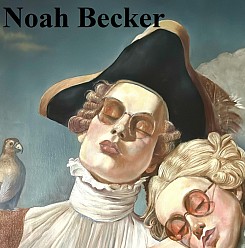Whitehot Magazine
December 2025
"The Best Art In The World"
"The Best Art In The World"
December 2025
April 07, WM issue #2: Francis Bacon's studio, Hugh Lane Gallery, Dublin

An artist's studio is a hallowed place to visit and Francis Bacon's studio at 7, Reece Mews was no exception. It became a fabled space during the artist's long and successful career. Situated on a quiet cobbled lane in South Kensington, London, this modest mews was his home for the last thirty years of his life. He moved in during the Autumn of 1961 and lived there until his death in 1992. During this period he produced some of his finest paintings, including 1973's "3 studies for a Crucifixion", all the while enjoying international recognition as one of the greatest painters of the 20th century.
The chaos of his Reece Mews studio became famous. Vying for floor space amid the boxes and slashed canvases were art catalogues, hundreds of photographs creased and torn, books on wildlife, male anatomy, Egyptian sculpture and the supernatural. Such diversity indicates the range of material Bacon consulted. The Dublin born artist said of his organized chaos, 'This mess here around us is rather like my mind; it may be a good image of what goes on inside me, that's what it's like, my life is like that'.
Francis Bacon was a creature of habit and all of his studios were within a two-mile radius of each other. Although be bought several other properties he never strayed from the Chelsea and Kensington areas. His unaffected ways were reflected in his words, 'I can only paint here in my studio. I've had plenty of others, but i've been here for nearly thirty years now and it suits me very well. I cannot work in places that are too tidy. It's much easier for me to paint in a place like this which is a mess. I don't know why but it helps me... For some reason the moment I saw this place I knew that I could work here. I am very influenced by places - By the atmosphere of a room'
After Bacon's death, John Edwards, his long-time companion and heir, concluded that his studio should be preserved in an appropriate location where it could be on public view. When he decided to donate it to the Hugh Lane, the gallery at once brought together the necessary expertise to excavate the studio and bring the contents to Dublin. As John Edwards said "a little corner of South Kensington moved to , his birthplace. Thousands of papers, books, photos, rotted curtains - all in Dublin. I think it would have made him roar with laughter..."
Prior to being dismantled and moved to Dublin, internationally renowned photographer Perry Ogden was commissioned in 1998 to photograph Francis Bacon's studio and living area just as they were left by the artist on his death six years previously. These photographs were taken before the gallery sent in a team of archaeologists and curators to make survey drawings and catalogue every item in the studio. Over 7000 items were cataloged before the studio was dismantled, transported and relocated in the gallery. The studio opened to the public in 2001 to international acclaim.
As well as seeing the studio through the lens of Ogden's camera, these photographs also show the kitchen cum bathroom and the living room cum bedroom where the artist lived. These last views of Francis Bacon's living spaces are very rare and capture the unique atmosphere of what were once the artist's most private spaces.
From 1961 onwards 7, Reece Mews was the center of his working life. The attachment was more emotional than rational, as the small space must have placed severe restrictions on him given the size of canvas on which he worked. He could never unite a triptych in the studio and could only enjoy their full impact when they were exhibited. The cramped studio exacerbated Bacon's acute asthma. During his time here, Bacon raised the ceiling and added a skylight, small comforts in so bantam a confine. In spite of these hermitic deprivations, Reece Mews was home to Bacon, and more importantly the well from which he sourced his art: 'I feel at home here in this chaos because chaos suggests images to me. and in any case I just love living in chaos. If I did have to leave and I went to a new room, in a week's time the thing would be in chaos. I do like things to be clean, I don't want the plates and things to be filthy dirty, but I like a chaotic atmosphere.'










